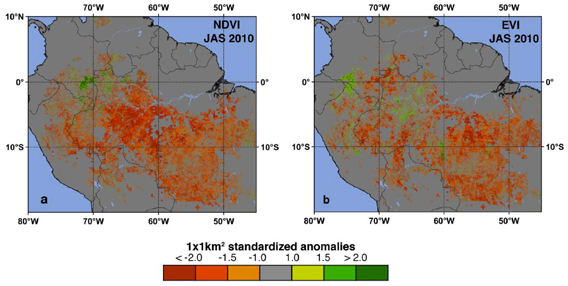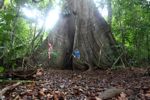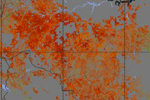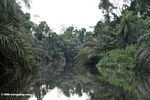
Forest fire in the Peruvian Amazon. Photo by: Rhett A. Butler.
The combined impacts of deforestation and climate change will bring a host of new troubles for the world’s tropical rainforests argues a new study in Trends in Ecology and Evolution. Drying rainforests due to climate change could lead to previously inaccessible forests falling to loggers, burning in unprecedented fires, or being overexploited by hunters.
“Not all tropical forests are going to dry out and warm up, but for those that do, we need to worry about more frequent and intense human-caused fires, as well as increasing accessibility to loggers and hunters,” lead author Jedediah Brodie with the University of Montana told mongabay.com.
Researchers call such impacts “synergistic,” because the combined effects of climate change and deforestation may be more severe than each considered in isolation. On the one hand, climate change is likely to open up new forests for exploitation, while on-going deforestation makes forests less resilient to climate impacts.
“Viewing climate change and tropical deforestation as unrelated issues will prevent us from addressing either one as efficiently as if we were to also consider the interactions between them,” Brodie says.
A rise of fires in tropical forests is of special concern, since many rainforest species are not adapted to fire. In healthy, intact rainforests, non-human started fires are incredibly rare. But climate change-exacerbated droughts is likely to bring more fire incidents.
“We need a massive campaign on fire education, awareness, and control all across the tropics,” notes Brodie.
The synergistic impacts of deforestation and climate change will also create a feedback loop, since the destruction and degradation of rainforest emits significant amounts of carbon, intensifying climate change.
“Having fewer trees also means less evapotranspiration and a decline in cloud cover, which could further exacerbate global warming because clouds are important for reflecting solar heat back into space,” Brodie adds, noting that, “It is also vital to immediately halt the destruction of tropical peat forests, since this can release huge amounts of carbon to the atmosphere.”
Brodie says the forests of Southeast Asia are currently most vulnerable to these impacts since “Southeast Asia has among the highest deforestation rates in the world, and several countries there are doing very little to reduce these rates.”
But no tropical forest is immune. Even the Amazon rainforest, the largest in the world, has seen two extreme droughts in the last decade alone. Scientists have long warned that the combination of drought and on-going deforestation in the Amazon could flip nearly half of the ecosystem from rainforest to savannah.
How do we protect rainforests in an age of climate change and on-going deforestation? Aside from cutting greenhouse gas emissions quickly, the study recommends that tropical nations coordinate with one another to create new protected areas and expand existing ones, focusing on areas vulnerable to climate and deforestation impacts. The nascent REDD program (Reducing Emissions from Deforestation and forest Degradation) should be crafted with an eye toward protecting vulnerable species, expanding protected areas, creating corridors between forests, and mitigating expanding agriculture in rainforests. In addition, governments worldwide should drop policies that support the destruction of rainforests.
“We need to convince governments to stop agricultural subsidies that indirectly promote tropical deforestation—such as ethanol subsidies in the US. We also need to ensure that further expansion of agriculture in the tropics is limited to degraded areas, and that intact forests remain (or become) connected into regional-scale protected networks,” Brodie says.
Already global average temperatures are 0.8 degrees Celsius (1.44 degrees Fahrenheit) higher than the Industrial Revolution. Depending on how quickly society acts to curb climate change, temperatures are expected to rise another 1.1 degrees Celsius (2 degrees Fahrenheit)—under the best case scenario—or up to 6.4 degrees Celsius (11.5 degrees Fahrenheit)—worst case—by the end of this century.
CITATION: Jedediah Brodie, Eric Post, and William F. Laurance. Climate change and tropical
biodiversity: a new focus. Trends in Ecology and Evolution. March 2012, Vol. 27, No. 3. doi:10.1016/j.tree.2011.09.008.

In 2010 drought hit the Amazon hard. Red and orange identify areas where satellite measurements indicated reduced greenness of the Amazon forest during the drought. (Green patches are areas of enhanced greenness.) The maps differ only in the method used for determining vegetation greenness from optical data. Click to enlarge.
Related articles
Humans drove rainforest into savannah in ancient Africa
(02/09/2012) Three thousand years ago (around 1000 BCE) several large sections of the Congo rainforest in central Africa suddenly vanished and became savannah. Scientists have long believed the loss of the forest was due to changes in the climate, however a new study in Science implicates an additional culprit: humans. The study argues that a migration of farmers into the region led to rapid land-use changes from agriculture and iron smelting, eventually causing the collapse of rainforest in places and a rise of grasslands. The study has implications for today as scientists warn that the potent combination of deforestation and climate change could flip parts of the Amazon rainforest as well into savannah.
Big trees, like the old-growth forests they inhabit, are declining globally

(01/26/2012) Already on the decline worldwide, big trees face a dire future due to habitat fragmentation, selective harvesting by loggers, exotic invaders, and the effects of climate change, warns an article published this week in New Scientist magazine. Reviewing research from forests around the world, William F. Laurance, an ecologist at James Cook University in Cairns, Australia, provides evidence of decline among the world’s ‘biggest and most magnificent’ trees and details the range of threats they face. He says their demise will have substantial impacts on biodiversity and forest ecology, while worsening climate change.
Rainforests need massive finance, but REDD must be well-designed to succeed

(01/17/2012) A proposed mechanism to reduce greenhouse gas emissions by protecting tropical forests has evolved considerably since it started to gain momentum during the 2005 climate talks in Montreal. Known then as ‘avoided deforestation’, the concept was simple: pay tropical forest countries to keep their forests standing. Since then, the concept has broadened to include activities beyond strict forest conservation, including reducing logging and fire, protecting carbon-dense peatlands, encouraging better forest management practices in existing forest concessions, and promoting reforestation and afforestation. A prominent voice in the discussion around REDD since its inception is the environmental activist group Greenpeace. Mongabay recently caught up with Roman Czebiniak, Greenpeace International’s Political Advisor on Climate Change and Forests, for an update on the organization’s position on REDD as well as recent developments in the forest carbon policy arena.
Last year’s drought hit Amazon hard: nearly a million square miles impacted

(03/29/2011) A new study on its way to being published shows that the Amazon rainforest suffered greatly from last year’s drought. Employing satellite data and supercomputing technology, researchers have found that the Amazon was likely hit harder by last year’s drought than a recent severe drought from 2005. The droughts have supported predictions by the Intergovernmental Panel on Climate Change’s (IPCC) that climate change, among other impacts, could push portions of the Amazon to grasslands, devastating the world’s greatest rainforest. “The greenness levels of Amazonian vegetation—a measure of its health—decreased dramatically over an area more than three and one-half times the size of Texas and did not recover to normal levels, even after the drought ended in late October 2010,” explains the study’s lead author Liang Xu of Boston University.
Not enough data on world’s tropical plants to predict impact of warming world

(02/14/2011) How many tropical plant species are threatened by climate change? Which plants have big enough ranges to survive a warming world, not to mention deforestation? How likely is it that the tropics are undergoing a current mass extinction? These questions may appear straight forward, but a new study in Global Change Biology finds that researchers lack the hard data necessary to come to any confident conclusions. According to the study, nine out of ten tropical plants from Africa, Asia, and South America lack the minimum number of collections needed (at least 20) to determine the species’ range, and therefore predict the impact of climate change.
Two massive droughts evidence that climate change is ‘playing Russian roulette’ with Amazon
(02/03/2011) In 2005 the Amazon rainforest underwent a massive drought that was labeled a one-in-100 year event. The subsequent die-off of trees from the drought released 5 billion tons of CO2. Just five years later another major drought struck. The 2010 drought, which desiccated entire rivers, may have been even worse according to a new study in Science, adding on-the-ground evidence to fears that climate change may inevitably transform the world’s greatest rainforest.
